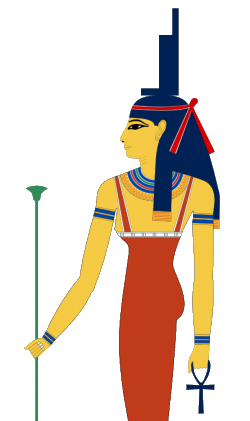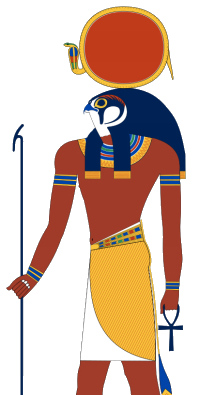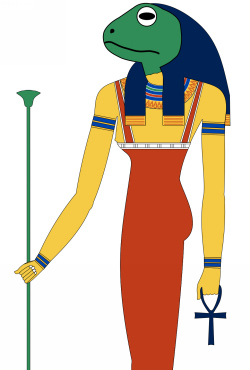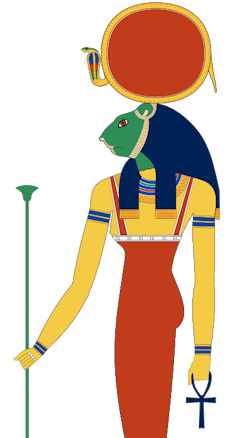Why Plagues?
It is easy to conclude that the only goal of Egypt's ten plagues was to free the Israelites from slavery. God sought, however, to also teach the Egyptians and their belief in pagan deities a valuable lesson!
And the Egyptians shall know that I am the LORD when I stretch forth My hand upon Egypt, and bring out the children of Israel from among them (Exodus 7:5).
For I will pass through the land of Egypt this night, and will smite all the firstborn in the land of Egypt, both man and beast. And I will execute judgment against all the gods of Egypt. I am the LORD (Exodus 12:12).
Deities Everywhere!
How many Egyptian deities did God ultimately judge with his plagues (Exodus 12:12)? The Bible nowhere mentions the name of any of Egypt's gods or goddesses except Pharaoh who was considered a god-king. Ancient history, however, reveals there existed an incredibly huge number of false deities that were worshipped!

"The beings in ancient Egyptian tradition who might be labeled as deities are difficult to count. Egyptian texts list the names of many deities whose nature is unknown, and make vague, indirect references to other gods who are not even named.
"The Egyptologist James P. Allen estimates that more than 1,400 deities are named in Egyptian texts, whereas his colleague Christian Leitz says there are "thousands upon thousands" of gods" (Wikipedia article on Ancient Egyptian Deities).
Judgment of the Gods
The Lord judged not only Egypt's deities as a whole, he also challenged the power and authority of individual gods. For example, a case can be made that the power of well-known and major Egyptian deities Amun and Ra (which became fused into Amun-Ra), Isis and Osiris were targeted in all the plagues.

Ra (Amun-Ra) was the foremost Egyptian sun god as well as the deity of kings and the sky. All forms of life were believed to be created by him.
The goddess Isis was believed to possess magical powers that exceeded all other deities. She was also considered the goddess of the Nile River who could cast healing spells to benefit ordinary people. Osiris was a deity of fertility, agriculture, life, vegetation and the annual flooding of the Nile.
Below is a list of other individual gods and goddesses whose authority and abilities were specifically challenged by each plague. It should be noted that some Egyptian deities had responsibilities or powers that either changed over time, overlapped others, or both.
Nile Turned to Blood
The first plague to befall Egypt was the Nile River and all the streams, etc. it fed turning to blood (Exodus 7:14 - 25).
The Egyptian gods judged in this miracle were Khnum, who controlled the Nile flood, as well as the lesser known Nile deity Neter-hau. Sobek was also targeted as he was, along with other powers, responsible for protecting others from the dangers of the river. There was also Hapi, a hermaphroditic deity (male / female), who was responsible for fertility and the Nile's annual flood.
Frogs
The second judgment upon Egypt was a huge swarm of frogs (Exodus 8:1 - 15).
The Egyptian goddess Heqet (Heket), a symbol of fertility, is portrayed with a frog's head. She was associated explicitly with the last stages of the flooding of the Nile. Her authority was specifically challenged in this plague.

Gnats and Lice
Gnats and Lice that came out of the dust of the land then struck both man and beast in Egypt (Exodus 8:16 - 19).
The Egyptian god Set, judged by this plague, was the deity of the Red Land (deserts) as well as storms, violence and disorder.
Flies
The fourth plague was a swarm of flies (Exodus 8:20 - 32) which may have been dog flies known for their painful bites.
The lower Egypt goddess Wadjet was symbolized as a cobra. She, coupled with her sister Nekhbet of Upper Egypt, were joint protectors of the entire country.
Pestilence
God's fifth judgment upon the Egyptians brought a destructive pestilence on the cattle, horses, donkeys, camels and sheep (Exodus 9:1 - 7).
The goddess Hathor was often depicted as a cow, one of the many animals affected by this plague. She was known as the goddess of love, beauty and joy. The major deity Khnum, responsible for controlling the Nile flood, was represented with the head of a ram. The deity Apis (Hapis), represented as a bull, was believed to be an intermediary between man and other false deities.
Boils
The sixth condemnation to come upon Egypt were open sores (festering boils) on both humans and animals (Exodus 9:8 - 12).
Deities judged in this calamity include the goddess Sekhmet who was portrayed with the head of a lioness. She was believed to have power to both bring plagues and ward off diseases. Interestingly, this pagan god is the one most represented in worldwide Egyptian collections.

Hail
An incredibly destructive hail was then called upon the people that destroyed the nation's barley and flax which was nearing harvest (Exodus 9:13 - 35).
Set, the god of storms, as well as the sky goddess Nut were judged in this plague. Also condemned were the god Neper and goddess Nepit who were responsible for grain.
Locusts
The eighth plague was a massive swarm of locust which devoured any plant or tree that still existed in the nation (Exodus 10:1 - 20).
Not only did God judge Nut the sky goddess in this trial, but also Reneutet who was the Egyptian goddess of grain, grapes and the harvest.
Darkness
The next to last trial pronounced on the Egyptians was a profound darkness that lasted for three full days (Exodus 10:21 - 29).
Horus, one of the most significant deities, was shown to be powerless before the Lord. Horus was notable as being the god of kings, healing, protection, the sun and the sky. The goddesses Nut and Hathor were also revealed to be completely helpless in saving the people.
Death of Firstborn
The final and greatest plague to befall the Egyptians was the death of the firstborn of every family who did not have lamb's blood over their door (Exodus 11:1 - 12:30).
The worship of Egyptian false gods such as Min, in charge of fertility and possibly orgiastic rites, as well as the goddess Heqet, was condemned in this great punishment.
Pharaoh himself, considered a living deity, was also judged. He was shown to be nothing more than a human who was incapable of saving his firstborn heir from the wrath of the one and only true God.
Conclusion
One of the primary goals of the ten plagues that came upon the Egyptians was to judge the staggering number of pagan deities they worshipped (Exodus 12:12). God's miraculous outpouring of his unmatched power conclusively proved that Egypt's deities were both powerless and useless. It also provided a profound eternal testament that He alone was worthy of mankind's worship.
And for this very purpose I (God) have raised you up (Pharaoh), to show My power against you, and that My name may be declared throughout all the earth (Exodus 9:16).